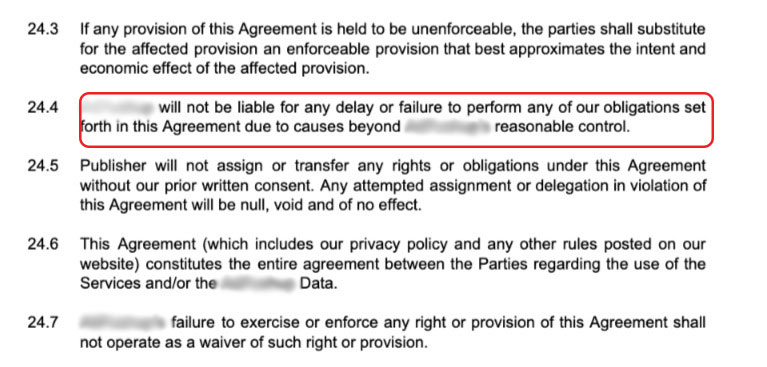Common Publisher Pitfalls And Website Fails That Are Costly
As a publisher, you’re constantly being bombarded by an increasing number of sources telling you what’s important to focus on and what’s next. What’s more, are things like SEO, monetization, GDPR, and other elements of the digital publishing ecosystem you have to keep track of on top of creating great content for your audience. This often can be the driving force behind major website fails and publisher pitfalls.
How can you tell what advice is objectively good for your site? “Expert” advice is often subjective and anecdotal at best. Or worse, the advice itself is self-serving because someone is just trying to make a quick buck off of the value you created.
While the digital publishing landscape continues to change at a breakneck pace, objective advice still exists that is valuable. But today, I’m going to walk you through common publisher pitfalls and how to avoid them.
Why websites should avoid contracts
The most common pitfalls for publishers are contracts. Contracts open the door to a massive host of issues relating to how a website is monetized, how an audience is treated or developed, and even how the business itself runs.
Anybody that wants to put you in a contract—whether it’s an ad network, a third party of some kind—they are putting you in a contract because they want to ensure something. You are a variable to them. So, it’s really important as a publisher to know the terms and conditions of a contract.

So if an ad network, a third-party responsible for monetization, or an ad partner wants to lock you into a contract, you should immediately be skeptical. Locking you in overpowers your ability to leave if you think they aren’t providing value. Or worse, you might even have to pay them money to leave.
The most common way publishers talk themselves into a contract is… “what do I have to lose?” … often, they won’t see the reason why it could potentially be a bad agreement for them. This begs the most important question — if the deal is so good that you won’t ever want out of it, why would you need a contract to legally obligate you?
What are your options if the business doesn’t perform the way you expected? If the only answer to that question is to pay money to be able to leave, that offers you zero flexibility and control. Avoid those types of contracts.
What if you start seeing links, bots, ads, or content on your site that you don’t like? Will you have control over what happens next? What if your traffic declines suddenly because of a change an SEO expert makes? Will you be able to tell them to stop that strategy or even get any money back?
Ad networks and ad ops shops are most notorious for this behavior. They lock people into contracts where it seems like it’s impossible to lose. If they write up a contract, they’ll make sure it sounds lucrative because their intention is to lock you in and then after that, figure out a way to get the money back out.
Are there any ‘good’ contracts for publishers?
Aside from being locked in a contract, if you do sign one, short-term is always better. You want to be able to get out as soon as you can if they aren’t holding up their end. You never want to sign a contract where someone is supposed to help you make money and you’ll physically owe them money to break it, especially if they are a monetization or SEO partner. Chances are, if you want to break that agreement, it’s because they are not delivering on what they promised.
We saw an example of this recently with DeadSpin and Farmer’s Insurance. Farmer’s Insurance agreed to have autoplay video ads on DeadSpin. The editorial staff rebelled against this because they thought it was terrible for user experience.
We’re re-posting the statement as a screenshot here as we gather more information. We thank you, our readers and supporters, for standing with us through this process. (2/3) pic.twitter.com/cRvMKeu2aF
— GMG Union (@gmgunion) October 29, 2019
Allow direct advertisers to cookie your users
When you allow advertisers to put tags on your site, it can have unintended consequences. If they cookie your users, they are essentially saying: I want to take your visitor information and advertise to them someplace else.
If advertisers want to advertise with you directly, oftentimes they will make the offer very lucrative-sounding. It’s doubtful they will flat out admit they want to target your visitors elsewhere, but in reality, they want to steal your audience for retargeting.

EXAMPLE: Sometimes if you visit advertiser sites directly, you will be cookied and then they will retarget you with their ads across the webs on various unrelated sites. While this is a common example of retargeting— the same thing would now occur when visitors landed on your site, not just theirs. They could display personalized ads on Facebook or The New York Times to your visitors!
The whole philosophy behind publishers receiving money from advertisers is because you have a relationship with your audience. They can’t get your audience anywhere else. The second advertisers cookie your users, they can. Once your audience members on your website are cookied, they can take the list and say, “Okay Google, Okay Facebook, I want to target these users on every other site.”
Under no circumstances is allowing this to happen a good long term strategy. If you have a site that you want to churn and burn right now by selling it, you could take some really short term cash. Realize that the majority of the time when direct advertisers want to cookie your users, it’s because they find your audience valuable and they don’t think you know any better.
Avoid selling 51% or more of your website
Many people have seen the show Shark Tank. Sometimes these investors strive for 51% of someone’s business because they gain decision-making control. They don’t want the entrepreneur getting in the way of their vision of generating profit. What could go wrong?
The same goes for your website—it still holds value just like if you were a brick and mortar business. There have been examples of this type of thing happening in the digital publishing space.
EXAMPLE: The #SaveSnopes campaign that was born out of difficulties Snopes had with a vendor, Proper Media. Proper Media was contracted to provide services for Snopes, but failed to acknowledge lawful termination of the contract. What resulted was a multi-year legal battle that intended to drain Snopes of their revenues during this time. Due to the fact Proper Media would not release Snopes’ CMS back to them, Proper Media continued to insert their own advertisements on the site and withheld all the ad revenue. Snopes founder David Mikkelson started a GoFundMe campaign to keep Snopes alive while their revenues were being drained through legal fees and without a lack of ad revenue. It raised nearly 1.5 million dollars, and ultimately the Superior Court of California ruled in the favor of Snopes. Proper Media was forced to release the CMS back to Snopes and repay the unpaid ad revenues collected during this time.

A similar occurrence happened to DeadSpin when chief executive Jim Spanfeller and editorial director Paul Maidment of G/O Media, Deadspin’s parent company, delivered a new directive to publish only sports and sports adjacent content. The entire editorial team quit after editorial battles that built up for months before the new directive attempted to change a publication that was known for being fiercely independent.
If a media company proposes you sell 51% of your company, they might guarantee your revenue will double. It seems like a great offer because they’re going to give you a lot of money upfront, they’ll double your revenue, and you get to just keep creating content.
The caveat is that you lose control. Whoever owns 51% can now make all the decisions about your site. What if they decide they’re going to pump and dump your site and just get their money back by jamming ads in, arbitraging traffic, and getting it banned by all major ad partners. Once they’ve gotten their money back, they sell off 51% of your site, and now someone else comes along and wants to change the site entirely and you’ll still have no control. THIS HAPPENS EVERYDAY.
The relationship you have with your audience is valuable. Never sacrifice control for a quick buck, because most likely, they don’t have your audience’s best interest (or yours) in mind.
Careful of changing MX Records / letting someone censor your email
Changing MX records is something to be wary of. Nameservers, A record, CNAME—these things are okay to change because it allows someone to be a proxy of traffic, like a CDN or host. Additionally, you can easily change those records back if you see or notice something you don’t like.
MX (Mail Exchange) records are DNS records that are needed for delivering email to your address. An MX record helps define to the rest of the world wide web which mail servers are accepting mail for your domain and where they should be routed to.
You should never change your MX records over unless you have a really good reason to. Why? Because when you proxy MX records through, you give somebody the ability to filter your email.

What you don’t want to happen is someone screening or filtering your emails.
If a partner you’re working with ever says, “Would you like us to handle all your requests for SEO services or ad services?” This might exist in the fine print of a terms and conditions document, and it may be a roundabout way of allowing them to access your site’s MX records.
The end result is that all those trying to reach out that might have something helpful to a publisher’s growth, or an important notice about account compliance or system errors, gets screened out and you won’t see it at all.
What if someone there drops the ball and causes you to get banned by Google’s Ad Exchange, or worse, deindexed in search results.
This practice is incredibly dangerous and is another reason why you should always read the terms and conditions of any partner you might work with.
Don’t be fooled by out clauses
In a lot of cases, publishers will be led along by statements like, “If we don’t hold up our end of the bargain, you’ll be released from whatever contract.” or “if we don’t deliver on what we say, we will reimburse 100% of the cost.”
Look at the fine print. Oftentimes, most contracts that third-parties make with publishers are along the lines of “If expectations aren’t met, this will be ultimately determined by the person making the clause.”
So in reality, that type of legal language creates a situation that ultimately gives power to the person writing the clause and putting you at their mercy.
Avoid native traffic-sharing scams
Native traffic-sharing is part of the third-party tech business. Lots of ad tech or ad ops businesses will tout “traffic sharing” or “traffic boosting widgets.” They make it seem like they are going to promote your site on these other sites, and they will promote other sites on your site, and everyone will get more traffic. Everyone’s happy—right?
The truth is that native traffic sharing tends to get really scammy if you don’t have a great grasp of how it will actually be deployed (few can offer this transparency). If you’ve seen the “You will never believe what she did next” type ads, they’re all the same. This is how many native ad networks send traffic around the web, and traffic sharing widgets can often be just as bad.

Where they offer to put a widget on your site that’s going to advertise content on someone else’s site and vice-versa. You don’t know what that type of content might look like.
Taboola’s “Feed” features an infinite scroll, so when visitors arrive at the site and scroll the widget continues to generate more and more sponsored content. So a publisher who may have thought they were putting a small space of sponsored content on their page would realize that in reality, there is this infinite scroll of sponsored content at the bottom of their pages.

Native traffic-sharing partners often say “Oh, the content is going to be in the same niche, it’ll be fine.”
The caveat to that is visitors that arrive on your site will see something different and in reality, you are sending traffic away from your site just in the hopes that another publisher reciprocates that traffic.
Small sites often hope that their content will appear on a big site; allowing them to attract a new quality audience. Unfortunately, this is exactly what these sites are supposed to think. Rarely is that ever how it works out.
How do you know if traffic sharing is legit or not? Here’s a better question… how do you know it will be all it’s cracked up to be? What data can you see?
While Google doesn’t hate native advertising, it certainly doesn’t like to be tricked either. It’s also something you have to be wary of because once that is on your page, you have no idea what kind of data or information is being communicated to the person who offered you the widget. Moreover, if the partners you are working with happen to be involved with any link schemes or PBNs, you could potentially be blacklisted from Google AdSense.
This is why you want to operate in accordance with Google policies and do your best to create high-quality sites for your users.
How to avoid violating major policies
An example of this is when publishers are told, “It’s okay, Google never enforces this policy, it’s okay.”
Multiple AdSense accounts on a single page is a good example of this. Google’s policies don’t allow this. All the time publishers are tricked into allowing this because people say, “Hey, I can boost your traffic or do some free SEO work, I just need you to put a couple of my AdSense tags on your page.”
You have to be careful about that, because at the end of the day what you put on your page, YOU are responsible for complying with policies.
Even if someone else tells you it’s going to be okay, you need to figure out whether you’re in violation of any policies for yourself.
Offloading your content somewhere else
There are some non-descript places you can offload your content to like Medium, which offers users an ad-free experience for a $5 a month subscription. What you don’t want to do is be fooled into redirecting all your traffic or housing your content somewhere else, especially if you’re monetizing your site through display ads.
The classic example of this is if you were making a bunch of money from Instagram and advertisers are saying, “Hey, you got a bunch of followers, we will pay you for x, y, or z.” Then, as a reaction to that, you decide to stop putting content on your blog and only put stuff on Instagram.

A similar phenomenon happened around the time of Facebook Instant Articles, and since then Facebook has pulled back a little. So imagine, if you have all your content in one basket (Instagram), and then Instagram suddenly decides to curtail their reach, the next thing you know the hub where you connect with your audience disappears.
Any place you can self-host or host your content is the safest bet. Platforms like Medium, or any of the social platforms, are great for interaction but not a fantastic place to host all of your content. These platforms also come with the added risk of if their usage declines, so does your audience.
Avoid domain-level URL overhauls
What is a domain-level URL overhaul?
All my content goes to alarmsandclocks.com right now, and I’ve been using that URL forever, and I just decided that I’m going to switch everything to nothingbutclocks.com and it’s a new domain.
There are a lot of variables to account for when you do these types of domain-level URL overhauls. Most of the time publishers will see a negative impact on SEO from doing a URL overhaul. This doesn’t mean you can’t do a complete domain-level redirect from one site or another.
It’s just in most cases, there’s usually something you miss. At the end of the day, even if you roll back all your changes in the case of messing something up, unless you revert the changes almost immediately, you’re probably going to be impacted no matter what.
It’s a huge risk and you’re going to have to ask yourself what is the reward, and also is the risk of losing traffic worth the reward at all?
Wrapping up how to avoid common publisher pitfalls
Though digital publishing is becoming more complex, avoiding these common publisher pitfalls is simple. You just need to meet proposals from third parties with immediate skepticism. Operate under this philosophy:
The relationship you have with your audience is what advertisers and third-party partners find value in. No matter how good an offer sounds, read the fine print. Anything that could compromise your earnings, or more importantly, the relationship you have with your audience, should be avoided.
Do you have any questions on these publisher pitfalls? Let me know in the comments.

